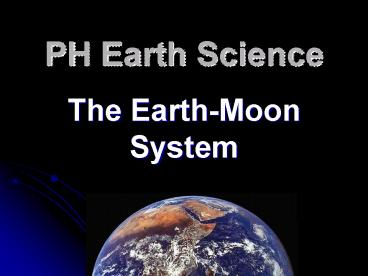PH Earth Science - PowerPoint PPT Presentation
1 / 23
Title:
PH Earth Science
Description:
Earth's revolution and seasons: Earth is tilted on its axis 23.5 degrees ... The four seasons, solstices and equinoxes. Earth's Natural Satellite: The Moon ... – PowerPoint PPT presentation
Number of Views:122
Avg rating:3.0/5.0
Title: PH Earth Science
1
PH Earth Science
- The Earth-Moon System
2
Planet Earth
- Earth is the third planet from the Sun.
- Earth rotates (spins) on its imaginary axis and
revolves (circles) around the sun. - Water occurs as a solid (ice), a liquid, or a gas
(water vapor) - Earth has one natural satellite, the moon.
- - Satellite Any object that revolves around
another object
3
- Earths rotation
- Causes day and night
- 50 of the earth is always lit by the sun.
- One rotation takes 24 hours (1 day)
- Earths revolution
- Earth revolves around, or orbits, the sun.
- One revolution takes 365 days (1 year)
- - Orbit the curved path followed by a satellite
(Earth is a satellite of the sun.) - Why do things orbit other things?
- GRAVITY!
4
- Earths revolution and seasons
- Earth is tilted on its axis 23.5 degrees
- This tilt combined with its revolution causes the
seasons. - Animation of revolution and seasons
- Summer occurs when a hemisphere is tilted towards
the sun winter occurs when tilted away - During summer, direct rays from the sun are more
concentrated, thus creating more heat energy
5
- Summer Solstice day that the North Pole points
towards the sun occurs June 21 North Pole
experiences 24 hours of daylight - Winter Solstice day that the North Pole points
away from the sun occurs Dec. 21 North Pole
experiences 24 hours of darkness - Vernal and Autumnal Equinox days when the North
Pole is pointed neither towards or away from the
sun - - most direct rays of the sun are focused at the
equator - -Spring March 21, Fall September 21
6
The four seasons, solstices and equinoxes
7
Earths Natural Satellite The Moon
8
The Moon
- Orbits Earth once every 29.5 days and also
rotates on its axis once every 29.5 days. This
means the same side of the moon always faces
Earth. - Has no atmosphere, no water, and no life.
- Is ¼ the diameter of Earth and has ¼ the
gravity of Earth. - Drastic temperature changes between the light
(hot) and dark (cold) side - due to the lack of
an atmosphere.
9
The Moon
- 50 of the moon is always lit by the sun it does
NOT give off its own light. - The portion of the lit side facing the earth
causes the phases of the moon. - The gravity of the moon and sun cause the Earths
tides - the daily, periodic rise and fall of
water level.
10
One Small Step
- 12 Americans have walked on the moon.
- Apollo 11 was the first manned mission to land on
the moon. - Neil Armstrong and Buzz Aldrin were the first men
to walk on the moon.
11
Q If ½ of the moon is always lit by the sun, why
do we not always see it? A Because the lit side
does not always face us! click for animation
Phases of the Moon
12
Phases of the moon
- New moon
- Waxing Crescent
- First quarter
- Waxing Gibbous
- Full moon
- Waning Gibbous
- Third Quarter
- Waning Crescent
- New moon
It is more important to know what causes the
phases than it is to remember all the names!
13
New Moon
14
Waxing Crescent
15
Waxing Quarter (1st)
16
Waxing Gibbous
17
Full Moon
18
Waning Gibbous
19
Waning Quarter (last)
20
Waning Crescent
21
New Moon
22
- Solar eclipses occur when the moon blocks
sunlight from Earths surface. (S m E) - animation
- Lunar eclipses occur when Earth blocks sunlight
from reaching the moons surface. (S E m) - animation
Solar Eclipse August 11, 1999 Soissons, France
23
One of Jupiters moons causing a solar eclipse on
Jupiter (notice the shadow).































